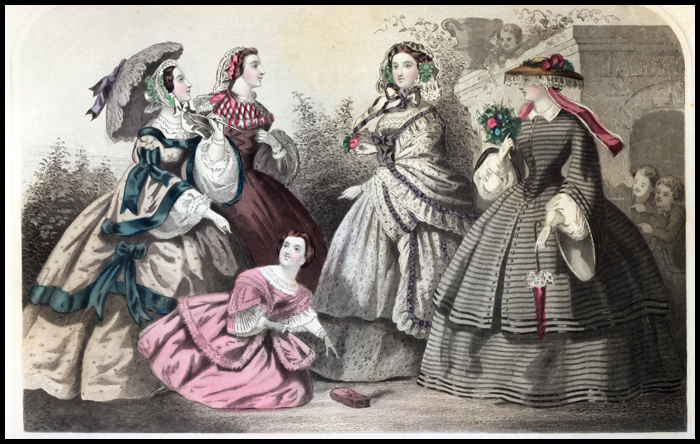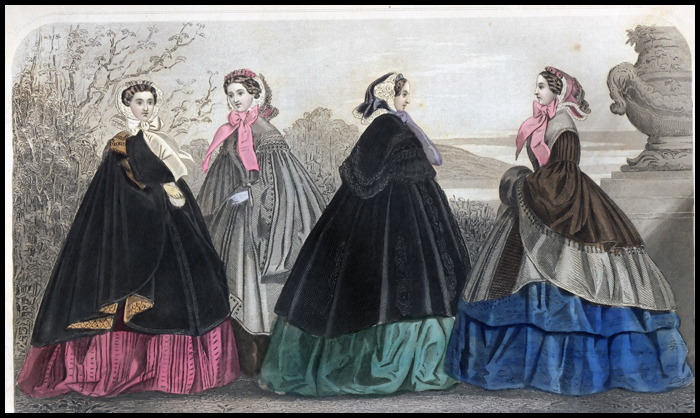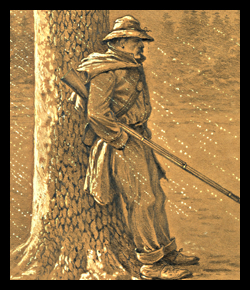Godey's Lady's Book and Magazine.This collection contains all sixty of Godey's monthly magazines (around 100 pages each) for the years from 1860 through 1864. Each of those five years contain two complete volumes: The first volume of each year contains all of Godey's magazines from January through June, and the second volume contains all of Godey's magazines for that year from July through December. Each monthly magazine showcased the latest fashions for that month, so there are twelve fashion plates for each year and sixty fashion plates for the five years. Each volume’s table of contents, for all five years, are combined in one pdf file. This allows browsing the entire archive by opening just one file. To facilitate fashion selection, each year’s fashion plates are grouped together in a separate folder. In addition to the fashions, the complete magazines in each book offer patterns, embroideries, designs, illustrations, sheet music, stories, and an abundance of everything that interested women during the Civil War.




Godeys on 4gb USB flash 24.95

Free Shipping USA and Canada
Godey's Lady's Book and Magazine, was a United States magazine which was published in Philadelphia. It was the most widely circulated magazine in the period before the Civil War. Its circulation rose from 70,000 in the 1840s to 150,000 in 1860. By the 1860s, Godey's considered itself the "queen of monthlies".
In Philadelphia in 1830, Louis Antoine Godey (1804-1878) began publishing Godey’s Lady’s Book (1830–1878), which he designed specifically to attract a growing audience of American women.
Godey intended to take advantage of the popularity of gift books, many of which were marketed specifically to women. Each issue contained poetry, articles, and engravings created by prominent writers and other artists of the time. In 1836 Godey purchased the Boston-based American Ladies’ Magazine, which he merged with his own publication. Most importantly, Sarah Josepha Hale (1788-1879) became Godey’s new editor. Under Hale’s tutelage the magazine flourished, reaching a pre-Civil War circulation of 150,000. Godey and Hale became a force majeure in American publishing and together produced a magazine which today is considered as among the most important resources of 19th century American life and culture.
Sarah Josepha Hale served as Godey’s editor from 1837 until 1877 and published only original, American manuscripts. She brought substance to the magazine, and wrote frequently about the notion of “women’s sphere.” In 1846 she stated, “The time of action is now. We have to sow the fields—the harvest is sure. The greatest triumph of this progression is redeeming woman from her inferior position and placing her side by side with man, a helpmate for him in all his pursuits.” Her steadfast devotion of purpose and her unwavering editorial principles regarding social inequalities and the education of American women, made her one of the most important editors of her time. When Hale started at Godey's, the magazine had a circulation of ten thousand subscribers. Two years later, it jumped to 40,000 and by 1860 reached 150,000 subscribers.
Although the magazine was read and contained work by both men and women, Hale published three special issues which only included work done by women. The magazine was intended to entertain, inform, and educate the women of America. In addition to extensive fashion descriptions and plates, the early issues included biographical sketches, articles about mineralogy, handcrafts, female costume, popular dance, equestrienne procedures, health and hygiene, recipes, remedies, and the like. Each issue also contained two pages of sheet music, written essentially for the pianoforte. Gradually the periodical matured into an important literary magazine containing extensive book reviews and works by Harriet Beecher Stowe, Edgar Allen Poe, Nathaniel Hawthorne, Henry Wadsworth Longfellow and other celebrated 19th century authors, who regularly furnished the magazine with essays, poetry, and short stories. Godey’s Lady’s Book also contained a vast reservoir of handsome illustrations which included hand-colored fashion plates, mezzotints, engravings, woodcuts, and ultimately, chromolithographs.
In 1845, Louis Godey began copyrighting each issue to prevent other magazine and newspaper editors from pirating texts. This move, a first in America, editors at the Baltimore Saturday Visiter criticized as a"narrowly selfish course" that Godey would later "rue it bitterly".
The magazine was expensive; subscribers paid $3 per year (for comparison, The Saturday Evening Post was only $2 per year). Hale took advantage of her role and became influential as an arbiter of American taste. She used some of her influence to further several causes for women. For example, in 1852 she created a regular section with the heading "Employment for Women" discussing women in the workforce.
In general, Godey disliked having political issues or controversial topics in his magazine. In the 1850s, he dismissed Sara Jane Lippincott ("Grace Greenwood") as assistant editor for denouncing slavery in the National Era, a weekly abolitionist newspaper. Lippincott publicly denounced Godey in response and Godey later recanted. Nevertheless, he forbade his journal from taking a position during the American Civil War. In fact, during the war, the magazine made no acknowledgment of it whatsoever and readers looked elsewhere for war-related information. The result - Godey's lost about one-third of its subscribers.
Before his death in 1878, Godey sold the magazine in 1877 to John Hill Seyes Haulenbeek. Twenty years later Haulenbeek died, and with him, the magazine.
Godey’s is best known for the hand-tinted fashion plate, which appears at the start of each issue and provides a record of the progression of women's dress. By 1859, Godey paid $105,200 to produce the Lady's Book, with the coloring of the fashion-plates costing $8,000. Almost every issue also included an illustration and pattern with measurements for a garment to be sewn at home. A sheet of music for piano provided the latest waltz, polka or galop.
Edgar Allan Poe had one of his earliest short stories, "The Visionary" (later renamed "The Assignation"), printed in Godey's in 1834. In 1844, he published several other works: "A Tale of the Ragged Mountains" (April), "The Oblong Box" (September), and "Thou Art the Man" (November). Other contributors included Nathaniel Hawthorne, Oliver Wendell Holmes, Washington Irving, James Kirke Paulding, William Gilmore Simms, Nathaniel Parker Willis, and Frances Hodgson Burnett.
Magazine editor Sarah Hale chose Queen Victoria as a role model of femininity, morality and intellect, and Godey's hired Mrs. Lydia H. Sigourney to report on the royal activities in London. The tradition of a white wedding is began with Queen Victoria's choice to wear a striking white wedding dress when she married Prince Albert in 1840. With American women following styles or dress set by the young Queen, in less than a decade after her wedding Godey’s wrote: “Custom has decided, from the earliest ages, that white is the most fitting hue, whatever may be the material. It is an emblem of the purity and innocence of girlhood, and the unsullied heart she now yields to the chosen one.”
A woodcut of the British Royal family with their Christmas tree at Windsor Castle, initially published in the Illustrated London News on December 1848, appeared in Godey's at Christmas 1850. Sarah Hale removed Queen Victoria's crown and Prince Albert's mustache to remake the engraving into an American scene. The republished image became the first widely-circulated picture of a decorated evergreen Christmas tree in America. Art historian Karal Ann Marling called Prince Albert and Queen Victoria shorn of their royal trappings "the first influential American Christmas tree". Folk-culture historian Alfred Shoemaker summed up that "in all of America there was no more important medium in spreading the Christmas tree in the decade 1850-60 than Godey's Lady's Book". The image was reprinted in 1860 and, by the 1870s, putting up a Christmas tree had become common in the United States.
During her reign as editor, Sarah Hale also used her influence to advocate for the establishment of a national Thanksgiving holiday, which President Abraham Lincoln established by proclamation in 1863. Godey’s Lady’s Book established new trends in America, which has now become an influential part of our national history.
Exceptional Content...Legendary Service


Compilations and Designs
© 2026 Civil War Digital
